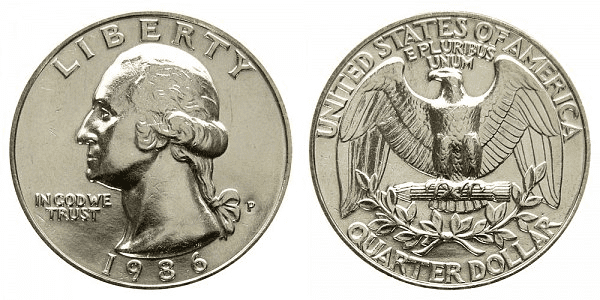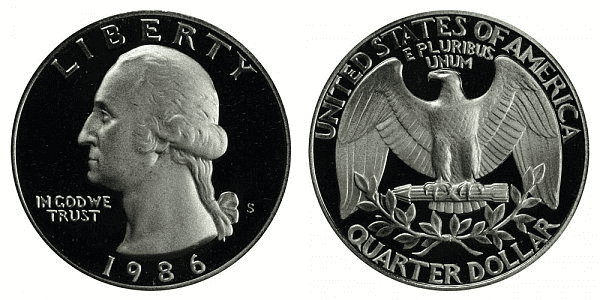What Is the 1986 Washington Quarter Value Made Of?
Beginning in 1968, the copper core and 8.33% nickel coating of the Washington Quarters took the role of the silver component. Based on Jean-Antoine Houdon’s bust from 1786, John Flanagan designed the picture of George Washington facing left on the coin’s obverse.
On the coin’s obverse, the phrase “LIBERTY” is inscribed all the way around Washington’s head, including the hair. Around the entire bottom of the smaller George Washington bust, the year “1979” is carved. The nation’s motto, “IN GOD WE TRUST,” is written to Washington’s left.
On the reverse of the coin, an Art Deco-inspired heraldic eagle perches above a cluster of arrows. Both the eagle’s head and the arrows point to the left. The eagle’s base is surrounded by two sprays of olive branches arranged in the shape of a U, and the words “United States of America” are printed all the way around the top of the coin.
The motto E PLURIBUS UNUM appears below it. The term “QUARTER DOLLAR” is printed on the coin’s base. The 1979 Washington quarter has a reeded edge.
The Chernobyl nuclear power plant meltdown made 1986 a disastrous year that altered history forever. The catastrophic Challenger shuttle tragedy and Halley’s comet’s closest approach to Earth both occurred in 1986.
1986 Quarter Value Varieties
1986 P Washington Quarter Value
Year: 1986
Face Value: $0.25
Composition: 91.67% Copper and 8.33% Nickel
Total Weight: 5.67g
Diameter: 24.3 mm
Thickness: 1.95 mm
Edge: Reeded
Minted in: Philadelphia
Quantity Minted: 551,199,333

1986-S Proof Washington Quarter
Year: 1986
Face Value: $0.25
Composition: 91.67% Copper and 8.33% Nickel
Total Weight: 5.67g
Diameter: 24.3 mm
Thickness: 1.95 mm
Edge: Reeded
Minted in: San Francisco
Quantity Minted: 3,010,497

1986 D Washington Quarter Dollar
Year: 1986
Face Value: $0.25
Composition: 91.67% Copper and 8.33% Nickel
Total Weight: 5.67g
Diameter: 24.3 mm
Thickness: 1.95 mm
Edge: Reeded
Minted in: Denver
Quantity Minted: 504,298,660

List Of Uncommon 1986 Quarter Dollars
Washington Quarter 1986-D
The fact that 1986-D clad Washington quarters are worth a little bit more than face value may seem completely illogical, especially in light of the fact that 1986-P quarters aren’t particularly valuable numismatically and that no other regular-issue US coins from 1986 are worth anything extra.
It’s interesting to see that 1986 saw comparatively few sales of uncirculated sets. The U.S. Mint provided the annual set during the 1980s, but only 1,153,536 mint sets were sold that year, the lowest distribution ever.
Additionally, the commemorative coin programme at the U.S. Mint was really picking up steam in the middle of the 1980s, and a lot of people just paid more attention to purchasing those than, say, saving rolls or bags of 1986-D Washington quarters.
Despite the fact that more than half a billion, or 504,298,660, of the 1986-D quarter, were produced, it is one of the more difficult to find clad coins.
Circulated 1986-D clad Washington quarters have sold in grades of Extremely Fine-40 for 50 cents or more, and they are worth $4 and above in uncirculated condition.
1986-P Washington Modern Quarter PCGS MS67

In 1986, more than 550 million contemporary quarters were produced. So it’s difficult to discover one that’s worth a lot of money. But one such example is this coin, which was struck in Philadelphia. The PCGS assigned it a grade of MS67. It was then one of the ten coins of that calibre that were known to exist. No coins graded higher than it have ever been discovered, and it also secured the joint highest rank for quality. In June 2019, Heritage Auctions put it up for auction. The winning bid came in just under $2,900 after the buyer’s premium.
How Much Is the 1986 Quarter Worth Today?
The low $0.052 melt value of a 1977 quarter serves as an example of how condition, flaws, and provenance all play a role in determining the worth (above the face value) of this money. This coin has no melt value because precious metal isn’t present. With the exception of MS-grade coins, which are only worth their face value since they are still in circulation, the majority of these coins’ value, excluding rarities, is determined by their condition.
| Coin | Condition | Grade | Mintage | Value |
| 1986 D Washington Quarters Clad Composition |
Uncirculated | MS-65 | 504,298,660 | $20 |
| 1986 P Washington Quarter | Uncirculated | MS-65 | 551,199,333 | $13 |
| 1986 S Proof Washington Quarter | Proof | PR-65 | 3,010,497 | $4.52 |
How Does The Grading System Work?
The Sheldon Scale is used by numismatists to provide a numerical value to coins. The Sheldon Scale goes from poor (P-1) to perfect mint state (P-1) (MS-70). Coins were originally evaluated using words to reflect their condition (Good, Fair, Excellent, Etc.). Unfortunately, coin collectors and dealers had different ideas about what each of these terms represent.
Professional numismatists joined together in the 1970s and established CoinGrading standards. These numismatists now assign grades at key places on the seventy-point scale, using the most regularly utilized numeric points in conjunction with the original adjective grade. The following are the most common coin grades:
-
-
- (P-1) Poor – Indistinguishable and probably damaged; if used, must have a date and mintmark; otherwise, rather battered.
- (FR-2) Fair – Nearly smooth, but without the damage that a coin graded Poor often possesses. The coin must have enough detail to be identified.
- (G-4) Fair – Inscriptions have merged into the rims in some areas, and important elements have been mostly erased.
- (VG-8) Very Good- A little weathered, but all of the primary design elements are visible, albeit faintly. There is little if any, central detail left.
- (F-12) Good – The item is very worn, yet the wear is even, and the overall design details stand out clearly. Rims are almost completely isolated from the field.
- (VF-20) Very Fine – Moderately weathered, with some finer features still visible. The motto or all letters of LIBERTY are readable. Both sides of the coin have entire rims that are separated from the field.
- (EF-40) Extremely Fine – Gently used; all gadgets are visible, and the most important ones are bold. The finer details are bold and clear, however, light wear may be seen.
- (AU-50) Uncirculated – Slight evidence of wear on the coin’s design’s high points; may have contact marks; eye appeal should be adequate.
- (AU-58) Uncirculated Choice – Slight traces of wear, no severe contact marks, almost full mint shine, and great eye appeal.
- (MS-60) Mint State Basal – Strictly uncirculated; no indication of wear on the coin’s highest points, but an unsightly coin with reduced luster, visible contact marks, hairlines, and other flaws.
- (MS-63) Mint State Acceptable – Uncirculated, but with contact scratches and nicks, little reduced shine, but otherwise appealing appearance. The strike is weak to average.
- (MS-65) Mint State Choice – Uncirculated with great mint shine, very little contact blemishes, and exceptional eye appeal. The strike is unusually severe.
- (MS-68) Mint State Premium Quality – Uncirculated with superb luster, no obvious contact marks to the naked eye, and exceptional eye appeal. The strike is quick and appealing.
- (MS-69) Almost Perfect Mint State – Uncirculated with perfect brilliance, a sharp and appealing strike, and extremely good eye appeal. A near-perfect coin with minor imperfections in the planchet, strike, and contact markings (seen only under 8x magnification).
- (MS-70) Mint State Perfect – Under 8x magnification, there are no tiny imperfections discernible; the strike is crisp, and the coin is perfectly centered on a beautiful planchet. Rarely seen on a coin, this coin is bright and whole, with original luster and exceptional eye appeal.
-
Where To Buy Or Sell 1986 Quarter Dollar?
It can be beneficial to carefully inspect a 1986 quarter in your collection for defects or distinctive features before considering selling it. Regular 1986 quarters fetch a few bucks on websites like Etsy and eBay and are coveted for their sentimental significance. If you encounter a 1986 quarter in your pocket change, it’s unlikely to be worth much as the condition will be non-mint, but still check for any lucrative errors.
If you’re unsure but believe you may have something rare, you can upload an image to a forum for coin collectors to ask for assistance; there are even some excellent tutorials by the U.S. Mint. You may prevent fraud while purchasing and selling rare 1986 quarters by only doing business with reputable, specialised dealers like Heritage Auctions.
FAQs
What quarters should you save?
1932-1964 Washington quarters are desirable because of the silver content contained within a coin.
What quarter is worth over $10000?
There are several quarters valued at over $10000, and, in fact, a fair few worth hundreds of thousands such as the 1804 Draped Bust Quarter at $157,702, the 1870 CC Liberty Seated Quarter at $150,000 and the 1871 CC Liberty Seated Quarter at $115,000.
What quarters from the 1980s are valuable?
1982 and 1983 quarters are the most valuable coins from this decade.
